Philippines: Q4 GDP growth projected at 7.4%
MANILA, Philippines — The economy likely accelerated by 7.4 percent in the fourth quarter of 2021 from 7.1 percent in the third quarter, according to Bangko Sentral ng Pilipinas (BSP) Governor Benjamin Diokno.
“The Philippine economy appears to have turned the corner and appears set for a faster growth,” Diokno said during the 25th general membership meeting of the Rotary Club of Manila.
The country exited the pandemic-induced recession that stretched through five quarters with a back-to-back GDP growth of 12 percent in the second quarter of last year and 7.1 percent in the third quarter.
The Philippines slipped into recession in 2020 with a record GDP contraction of 9.6 percent as the economy stalled when the government imposed the longest and strictest lockdown in the world to slow the spread of COVID infections.
Despite the rising number of cases due to the more contagious Omicron variant, Diokno is confident that the seven to nine percent GDP growth target for 2022 set by the Development Budget Coordination Committee (DBCC) is attainable.
“Our position is that, despite the recent variant of the virus, we will hit our projected growth of seven to nine percent. So the variant, as it turned out, is mild and less lethal. We’re early in the year right, so we hope that the variant will be gone by the middle of February or March,” Diokno said.
On inflation, Diokno said the Monetary Board expects inflation to ease to 3.3 percent this year and 3.2 percent next year after accelerating to 4.5 percent last year from 2.6 percent in 2020, exceeding the BSP’s two to four percent target.
“For monetary authorities around the world, the foremost question is whether the elevated inflation is temporary or permanent in nature. Views diverge. A number of central bankers chose to tighten monetary policy to keep their economies from overheating while others opted to take a wait-and-see approach,” Diokno said.
The BSP chief pointed out the elevated inflation last year was driven largely by supply-side pressures and does not warrant monetary interventions at this time.
“Recall that in 2019, we were able to tame inflation after reforming rice trade. We should do more of liberalization of food items. Beware of politicians and pseudo economists who advocate that we should reverse what the Duterte administration has done on the liberalization of food items. Policy reversal will be disastrous, should that happen,” he said.
He added there is no need to follow other central banks that already raised interest rates in the face of persistently elevated inflation.
“To me, the harm of tightening monetary policy too soon exceeds the harm of moving too late given that the Philippine economy is still at its nascent state of recovery,” Diokno said.
Although the pandemic is unprecedented in scale and scope, he said the current global health crisis is unlike other crises in the past.
“Previous Philippine crises were characterized by rising interest rates cum depreciating peso, aggravated by foreign exchange outflows,” Diokno said.
As part of its COVID response measures, the BSP slashed interest rates by 200 basis points, bringing the benchmark rate to an all-time low of two percent in 2020. The central bank has maintained an accommodative stance by keeping a low interest rate environment to allow economic recovery gain more traction.
Likewise, latest data from the central bank showed the country’s gross international reserves (GIR) amounted to $108.89 billion in end- 2021.
“We should not let the pandemic derail our long-term goals. With or without crisis, we should continue to pursue structural reforms that would put the Philippines not just on the road to pre-crisis growth but on a sustainable path of development,” Diokno said.
Source: https://www.philstar.com/business/2022/01/17/2154307/q4-gdp-growth-projected-74


 English
English




